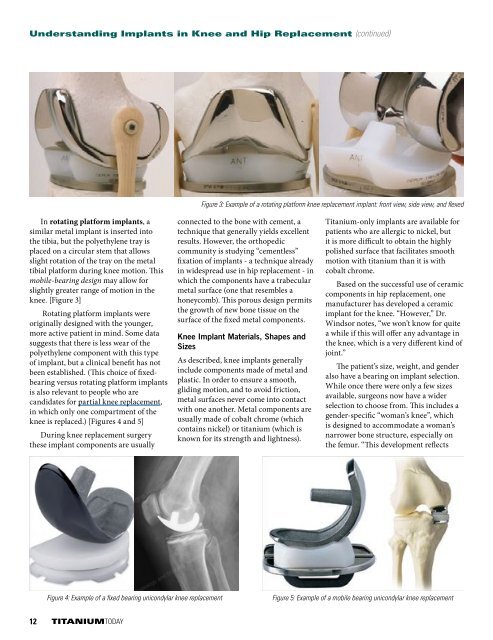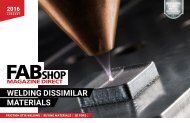100% Positive Material Identification
23mhiW2
23mhiW2
Create successful ePaper yourself
Turn your PDF publications into a flip-book with our unique Google optimized e-Paper software.
Understanding Implants in Knee and Hip Replacement (continued)<br />
Figure 3: Example of a rotating platform knee replacement implant: front view, side view, and flexed<br />
In rotating platform implants, a<br />
similar metal implant is inserted into<br />
the tibia, but the polyethylene tray is<br />
placed on a circular stem that allows<br />
slight rotation of the tray on the metal<br />
tibial platform during knee motion. This<br />
mobile-bearing design may allow for<br />
slightly greater range of motion in the<br />
knee. [Figure 3]<br />
Rotating platform implants were<br />
originally designed with the younger,<br />
more active patient in mind. Some data<br />
suggests that there is less wear of the<br />
polyethylene component with this type<br />
of implant, but a clinical benefit has not<br />
been established. (This choice of fixedbearing<br />
versus rotating platform implants<br />
is also relevant to people who are<br />
candidates for partial knee replacement,<br />
in which only one compartment of the<br />
knee is replaced.) [Figures 4 and 5]<br />
During knee replacement surgery<br />
these implant components are usually<br />
connected to the bone with cement, a<br />
technique that generally yields excellent<br />
results. However, the orthopedic<br />
community is studying “cementless”<br />
fixation of implants - a technique already<br />
in widespread use in hip replacement - in<br />
which the components have a trabecular<br />
metal surface (one that resembles a<br />
honeycomb). This porous design permits<br />
the growth of new bone tissue on the<br />
surface of the fixed metal components.<br />
Knee Implant <strong>Material</strong>s, Shapes and<br />
Sizes<br />
As described, knee implants generally<br />
include components made of metal and<br />
plastic. In order to ensure a smooth,<br />
gliding motion, and to avoid friction,<br />
metal surfaces never come into contact<br />
with one another. Metal components are<br />
usually made of cobalt chrome (which<br />
contains nickel) or titanium (which is<br />
known for its strength and lightness).<br />
Titanium-only implants are available for<br />
patients who are allergic to nickel, but<br />
it is more difficult to obtain the highly<br />
polished surface that facilitates smooth<br />
motion with titanium than it is with<br />
cobalt chrome.<br />
Based on the successful use of ceramic<br />
components in hip replacement, one<br />
manufacturer has developed a ceramic<br />
implant for the knee. “However,” Dr.<br />
Windsor notes, “we won’t know for quite<br />
a while if this will offer any advantage in<br />
the knee, which is a very different kind of<br />
joint.”<br />
The patient’s size, weight, and gender<br />
also have a bearing on implant selection.<br />
While once there were only a few sizes<br />
available, surgeons now have a wider<br />
selection to choose from. This includes a<br />
gender-specific “woman’s knee”, which<br />
is designed to accommodate a woman’s<br />
narrower bone structure, especially on<br />
the femur. “This development reflects<br />
Figure 4: Example of a fixed bearing unicondylar knee replacement<br />
Figure 5: Example of a mobile bearing unicondylar knee replacement<br />
12 TITANIUMTODAY







